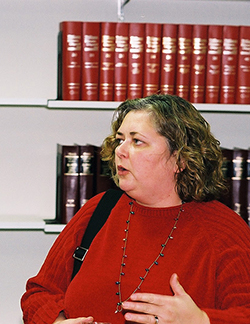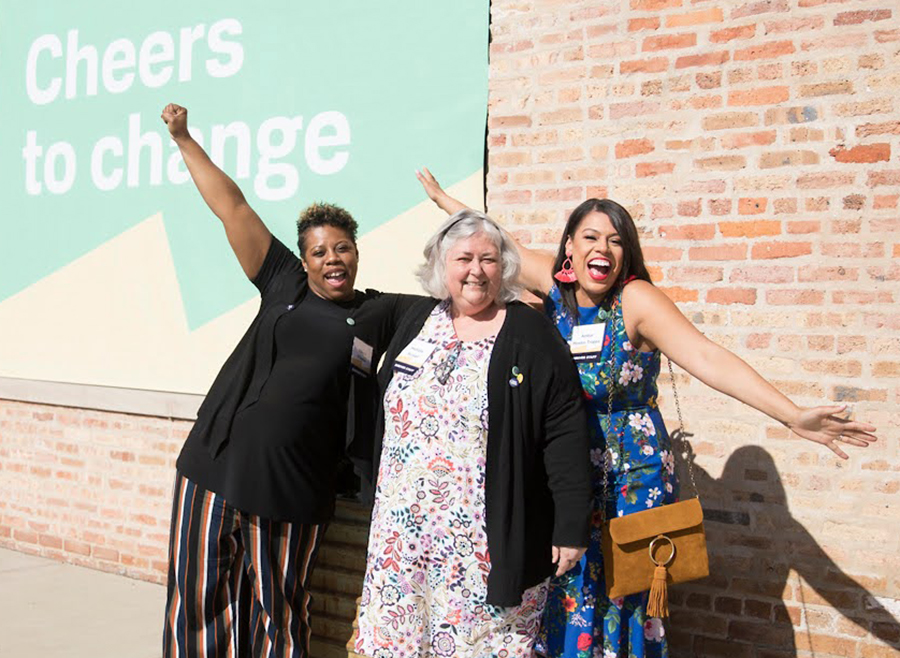Reflections on four decades of using the power of words to fight for racial and economic justice.
May 23, 2023
What was your first job at the Shriver Center on Poverty Law? How did your role change though the decades?
My first job was as the copy editor for Clearinghouse Review, a monthly journal published by what was then called the National Clearinghouse for Legal Services. The Review, which was delivered to nearly 10,000 federally funded legal services advocates, featured articles on legal developments in poverty law and summaries of cases being brought across the country. A few years after I started in 1984, I was promoted to one of a handful of legal editors responsible for developing and editing content for the journal.
In the late 1990s, I became increasingly interested in emerging digital technology, and I built the organization’s first website. Over the years, I continued to explore new ways of communicating with our audiences, including email marketing, social media, and even video. Eventually, I joined our newly established communications department in 2016.
How important is strategic communication to legal advocacy work?
Legal advocacy and strategic communications go hand in hand. Before we can change the law, we need to change hearts and minds. We need to tell the stories of people impacted by inequitable systems and clearly describe the better world we want to see. As our President & CEO Audra Wilson has said, changing the narrative about poverty and race is critical to our mission.
What was it like back when you joined the organization?

When I first started, we had about a dozen staff members, some working on Clearinghouse Review, and some maintaining a brief bank of thousands of case documents sent to us by legal services lawyers across the country. This was before the internet — advocates sent us pleadings in their groundbreaking cases, and we literally copied and mailed those documents out to lawyers who read about the cases in the Review and requested them. We were located in the Chicago Loop, in the landmark Old Colony Building.
In addition to the name changes, how has the organization evolved over time?
The Shriver Center on Poverty Law has changed a lot over the years! Probably the biggest changes came in 1996 when came Congress drastically cut federal funding for legal services, and the National Clearinghouse (along with other national support centers) was eliminated. At the same time, Congress enacted numerous restrictions prohibiting programs funded by the Legal Services Corporation from participating in class actions, welfare reform advocacy, and most affirmative lobbying and rulemaking activities. In response to these changes, members of the welfare team at the Legal Assistance Foundation of Chicago (now Legal Aid Chicago) joined forces with us. Together, we hoped to continue our work to end poverty.
Over time, our work became more intertwined; our new advocates wrote articles for Clearinghouse Review, and the Review shared our unique advocacy approaches with subscribers. Meanwhile, the organization grew, building on its accomplished advocacy staff and bringing in training capacity with the acquisition of the Center for Legal Aid Education in 2011. We innovated new methods of information sharing, making the Review and its archives available online; offering webinars, reports, and podcasts; and connecting advocates through networks. In 2003, we adopted our founder’s name and evolved into the Sargent Shriver National Center for Poverty Law.
What’s changed the most and the least?
Well, all the staff have gotten younger than me! But seriously, I think that the mission has stayed the same, but the ways we do the work have changed. When I started, we communicated through print. If you were in a hurry, you might send a fax. Now, we have email and websites and social media platforms. And we also have an advocacy program advancing innovative policy solutions on the ground, a training program teaching advocates how to do the work, and national networks connecting advocates to one another and best practices. We’re still working to support effective advocacy for racial and economic justice — we’re just doing it in new and different ways.
What drew you to the Shriver Center? What has kept you here for 40 years?
The mission. I was an idealistic 24-year-old who was wondering what to do with her English major when I started. I was thrilled at the prospect of using my writing and editing skills to support anti-poverty work.
I’ve enjoyed learning new things and growing professionally as the organization has evolved. One of my favorite memories is from 2016, when the Shriver Center formally established a communications department. In February, President Obama made a speech before the Illinois State Legislature to call for “a better politics” and more bipartisan lawmaking. Most of the staff gathered in the office conference room to watch, including our new Vice President of Communications, who had started on the job that day. About 10 minutes into his speech, to our great surprise, the President gave the Shriver Center and our then president, John Bouman, a shoutout. “[B]ecause someone like my friend, John Bouman, who worked at the Shriver Center on Poverty Law, helped us build coalitions across the state … we were able to increase tax credits for the working poor and expand health insurance for children in need,” Obama said. We all whooped in delight!
What accomplishment are you most proud of?
I’m most proud of our 2019 rebrand. The yearlong effort, led by Ambar Mentor-Truppa, was a tremendous opportunity to bring all the Shriver Center’s stakeholders together around a common understanding of who we are and what we are trying to accomplish. We built tools and messages that are foundational to our communications work. And I learned so much! It’s been gratifying to see the brand come to life and support all the work that the Shriver Center does and aspires to do.

What’s the most important learning you’ve had here?
Stay open and curious. Change is inevitable and constant. Information technology, in particular, has dramatically changed my work. It’s exciting to embrace new ways of doing things and to learn from new colleagues.
How have DEI practices/understanding evolved at Shriver?
We’ve made significant strides in the past several years, and we continue to grow in this area. As a nearly 60-year-old legacy civil rights organization, we were born out of a different mindset about the relationship between race and poverty — and that creates challenges. Internally, we’ve had deep conversations, changed hiring policies and practices, and established affinity groups. And we are bringing these learnings to the field through programming like the Racial Justice Institute. I’m proud to note that a majority of our executive leadership team is currently people of color.

What about Shriver’s future makes you most excited?
The Shriver Center is well-positioned to make a substantial impact both in the legal services sector and the broader fight for racial and economic justice over the next few years. We have seasoned leaders from diverse backgrounds. We have strong programs and smart, dedicated staff. As we continue to knit the direct advocacy work, training programs, and networks together, I think we have an unparalleled opportunity to make meaningful change that improves people’s lives.
After 40 years at the Shriver Center, Michelle Nicolet is retiring. Her last day is May 31, 2023.